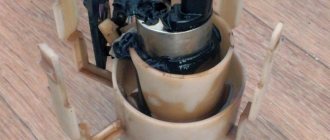Hello, dear friends! As part of our material today, I’ll tell you how to drain water from the washer reservoir and what may be required for such tasks.
Winter is approaching, and therefore before the onset of cold weather it is better to fill it with fresh and high-quality anti-freeze. We have already talked to you about choosing the best anti-freeze for your car, so just follow the link and read our previous material. It will be interesting and very useful.
Yes, the easiest way to drain the washer fluid is to dismantle the tank and pour out all the residue. But it is not always possible to easily remove the knot. The reason lies in difficult access to the tank on some cars, or because the liquid is simply frozen.
We study the correct passage of intersections of equivalent roads
- the water in the washer is frozen, and frozen water cannot be used in any way;
- if it is ordinary water, when the temperature drops it can cause serious problems;
- tap water clogs the windshield washer nozzles;
- There are often fakes on sale that are best removed from the system immediately;
- if mixed incorrectly, a chemical reaction may occur and the antifreeze will turn into jelly;
- there is a possibility of failure of the washer motor;
- The liquid is old and no longer copes with its tasks.
There are more than enough reasons. Therefore, the driver will have several compelling arguments in favor of draining the old fluid and pouring new fluid into the tank.
Many people don’t want to dismantle numerous components just to get to the washer tank and pour out all the remnants of the composition.
Therefore, it is important to look for alternative ways to solve this issue. Please note that every car is different and may have a slightly different reservoir location.
Check your owner's manual, or just look under the hood. Assess how easy it will be for you to dismantle the unit if you have:
- Lada Granta;
- Hyundai Solaris;
- Volkswagen Polo Sedan;
- Lada Vesta;
- Skoda Octavia;
- Ford Focus;
- Renault Logan;
- VAZ 2114;
- Skoda Rapid;
- Kia Rio;
- Mercedes C class;
- Mitsubishi Galant, etc.
I propose to separately consider several methods when the washer is in a liquid aggregate state, as well as in situations where it is frozen. To drain, you will first have to defrost the composition.
How to drain water from the washer barrel
Every car has a washer reservoir into which a special windshield cleaner is poured. It doesn’t matter what you pour in there: water or a special product purchased at a car store, it still needs to be changed periodically.
Why do you need to empty the washer fluid reservoir?
There are many reasons why experts recommend draining all windshield washer fluid from the reservoir. Let's list the most common ones.
- In summer you can pour distilled water into the container, but in winter it will freeze, which is very dangerous for the car. Therefore, it is imperative to change the summer product to a special, non-freezing winter product.
- Often, antifreeze is counterfeited or diluted with water. If you notice an unpleasant odor (it is a sign of poor quality), you should immediately pour out all the liquid from the windshield washer container and replace it with a new one.
- If you bought a product from another manufacturer, before filling it in, you need to get rid of the old one. By mixing products from different manufacturers, a chemical reaction can begin, and instead of windshield washer, a jelly-like mass is formed.
How to properly drain fluid from the washer fluid reservoir
Since all cars have a different design, the process of draining windshield washer fluid from a special container may differ for them. The easiest way to cope with this task is for owners of old cars that are more than 10 years old. Due to the fact that they have enough free space under the hood, they can easily remove the washer pump, remove the reservoir and pour out everything that is left in it.
Under the hood of modern cars, all the parts are too close, almost adjacent to each other. Therefore, it will be a little more difficult for owners of such cars to cope with this task. Sometimes it is even necessary to remove the wheel to get to the reservoir. On some cars you even have to remove the bumper. However, knowing certain subtleties of this process can make the work much easier.
If there is very little liquid left in the container, you can use the standard washer pump. We turn on the pump and wait until it pumps out the remaining liquid from the container. Do not turn it on for a long time, as this may cause damage to the electric motor. If there is a lot of liquid in the container, you will have to use other methods to drain it.
There is another, universal way. To empty the container, we need some kind of thin, ideally transparent hose. It will help you quickly get rid of fluid. But it is not only in the tank, but also in the pipelines. You can use an air compressor to empty them. It is necessary to disconnect the tube from the pump and apply compressed air to it.
Attention! Watch your pressure! It should be moderate so as not to harm the system.
As it turned out, it is not so difficult to drain the washer fluid from the washer reservoir. You can do this yourself without contacting car services. You will be able to save both time and money.
The cold season has arrived, and many drivers do not know how to drain the washer fluid from the washer reservoir. There are many different reasons for this. Owners solve such problems each in their own way, some try to solve such a problem on their own, and some are ready to pay a certain amount for the provision of such a service by specialists. But there is no need to purchase special equipment or tools, you just need to know the structure of your own car in order to do such work yourself.
All car owners will be interested in learning how to drain the washer fluid from the washer reservoir. This operation should not be avoided, as the consequences can be dire for the windshield washer system and headlights of your car.
Content
What is being put into the system?
In the last century, drivers could give only one answer to the question of what was poured into the washer reservoir: it was simple water. At that time, we had not even heard of special liquids for these purposes, and the glass washer system itself was not installed on all cars. An increase in the number of cars on the roads, changing climatic conditions, ensuring traffic safety in bad weather conditions and other factors forced developers to pay more attention to the development of this system.
In addition to cleaning windshields, dirt flushing systems for headlights have also appeared. Instead of water, special liquids began to be poured into the system, which contain chemical additives that improve the quality of glass cleaning, do not leave streaks, because they can impair the view of the road surface while driving, and also do not freeze when cold weather sets in, which is important for areas with long and cold winter.
Why does it need to be changed?
It is impossible to answer this question definitely, since there are quite a lot of reasons for a change. If the system is filled with water, it can simply freeze in winter, which can lead to damage to the washer pump, rupture of the tubes supplying the composition to the nozzles, and failure of the sprinklers themselves. The use of tap water is also undesirable because precipitation, with prolonged use, leads to clogging of the tubes and nozzles.
Sometimes problems arise when using anti-freeze products, especially when purchasing counterfeit products. Unscrupulous manufacturers sometimes use alcohol-containing compounds that pose a health hazard. If unpleasant odors appear during use, it must be replaced immediately. Sometimes it happens that by mixing products from different manufacturers, a chemical reaction occurs and the liquid turns into a jelly-like composition.
How to drain?
This also cannot be done with one piece of advice for all car enthusiasts, since each car model has its own system for cleaning the windshield and car headlights. The easiest way to drain cars from the last century. The body shape of such cars did not strive much for aerodynamic perfection; there was a lot of free space under the hood. Therefore, to replace it, it was enough to remove the washer pump, remove the reservoir from the bracket and drain its remains.
It is very difficult to call the engine compartment of modern cars free, so the place to install the washer reservoir, and the shape of the body of such products, can be the most unexpected. In some models it is installed in the area of the front bumper, in others near the radiator, and in some, such as in Renault Logan, under the protective grille near the windshield.
Among modern cars, the easiest way to do this is on the domestic VAZ Priora and Kalina models, in which they are installed in accessible places. In other models you will have to suffer a little, since in some cars you will need to remove the front wheel and fender liner, and in others you will also need to remove the bumper. But you can avoid such “showdowns”; let’s talk about this in more detail.
To do this, you need to find a thin transparent (more convenient, since the pumped-out liquid is visible) hose, and pump out its remains in any available way. It is quite difficult to achieve an absolute result, but it is not scary. The work does not end there, as you still need to get rid of residues in the pipelines, especially in those models where the flush also works on the rear window. This can be done using an air compressor. To do this, disconnect the tube from the pump and supply compressed air to the system, but you must not abuse its pressure so as not to damage the pipelines.
As you can see, there are no particular difficulties in this. We tried to tell you how to drain the washer fluid in accessible words. It is impossible to describe all the features for a large number of models. However, if you take this article as a basis, you can drain the “anti-freeze” from any model.
Or rather, a bad anti-freeze agent that I diluted myself. On the passenger side you unplug the connector, simply put a cloth under it and push the bottle, and it holds perfectly and does not fall. And no outside help is required! It turns out to be a kind of life hack)!
FakeHeader
Recommendations
Comments 85
Guys, I have never encountered such crap that is happening to me now... Yesterday I realized that the washer was frozen. I warmed it up, drained everything, filled it with anti-freeze at -30, poured it on the glass so that the remnants of the previous washer came out of the hoses and calmed down. This morning I went out and saw that the glass was covered with frost and decided that I would quickly spray it with anti-freeze and use the wipers to clean this whole thing up. Fuck there! It's frozen again! The anti-freeze product, tested by many car enthusiasts, has been purchased in large quantities from the same supplier for many years now. What the hell could this be?
Yes, it's crazy, why be surprised. Warm it up again, drain it. Or dilute it. And on the contrary, I leaked the one, thought Khrenovaya. I put it on the balcony and it doesn’t freeze at - 12 =)
So it doesn’t freeze in a bottle in my trunk. Could it be that the nozzles of the injectors are metal and because of this it freezes in the nozzles?
Try warming it up with your fingers, it helped me so much.
hmmm... I'll try. I'll go to the car right now. The main thing is not to freeze your fingers))
Try warming it up with your fingers, it helped me so much.
strange... So far it hasn’t frozen anymore O_o I’ll hope that it won’t freeze))
Guys, I have never encountered such crap that is happening to me now... Yesterday I realized that the washer was frozen. I warmed it up, drained everything, filled it with anti-freeze at -30, poured it on the glass so that the remnants of the previous washer came out of the hoses and calmed down. This morning I went out and saw that the glass was covered with frost and decided that I would quickly spray it with anti-freeze and use the wipers to clean this whole thing up. Fuck there! It's frozen again! The anti-freeze product, tested by many car enthusiasts, has been purchased in large quantities from the same supplier for many years now. What the hell could this be?
My anti-freeze also froze (perhaps there were remains of a fly swatter there), but we added industrial alcohol and it still froze =/ I’ll have to go to the subway again, defrost it and pump it out with a syringe. First time this has happened in 5 winters
The other day my husband and I were sucking out a fly swab with a syringe in my car =D wow, what a fascinating activity))) The main thing is to do it with a sense of idiocy. Had a blast)))
Ksyusha wrote above: syringe for Zhane. Business for a few minutes, that is, if the tank is full. I drained the same thing, I forgot that in the summer I filled it with distillate with a special tablet










